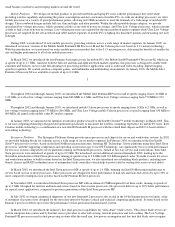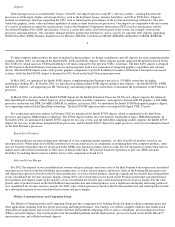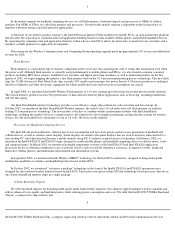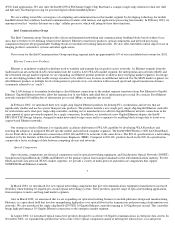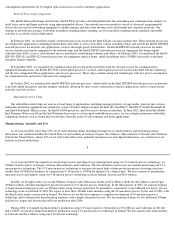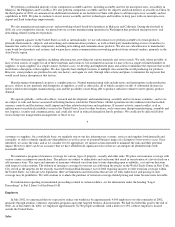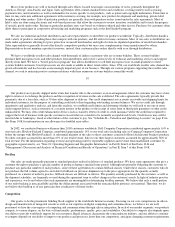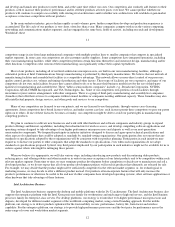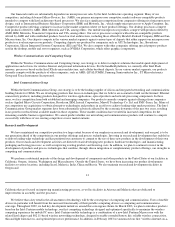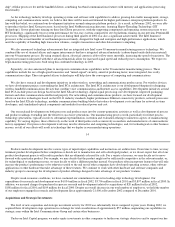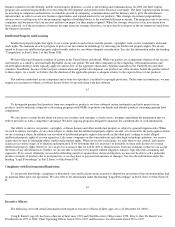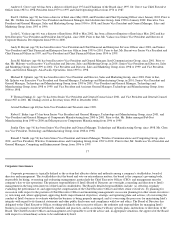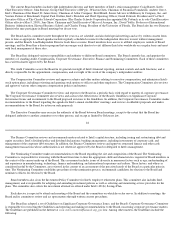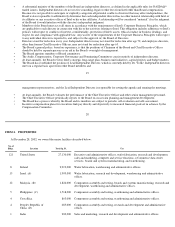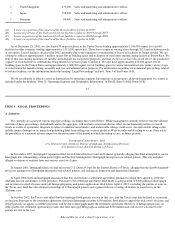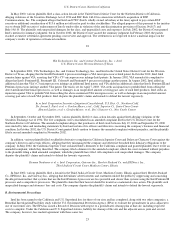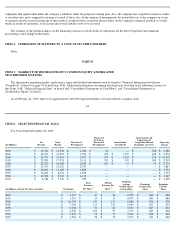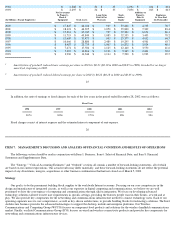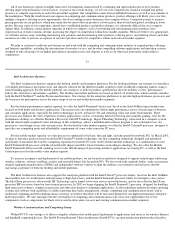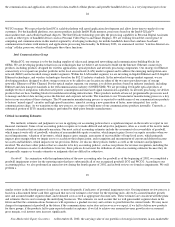Intel 2002 Annual Report Download - page 16
Download and view the complete annual report
Please find page 16 of the 2002 Intel annual report below. You can navigate through the pages in the report by either clicking on the pages listed below, or by using the keyword search tool below to find specific information within the annual report.
business initiatives for the desktop, mobile and enterprise platforms, as well as networking and communications. In 2002, the Intel Capital
program also assumed responsibility for overseeing the development and growth of new businesses internally. The Intel Capital program focuses
on investing in companies and initiatives to stimulate growth in computing, communications and the Internet, and to grow the information
infrastructure, in order to create new business opportunities and expand markets for our products. This strategic investment program helps
advance our overall mission to be the preeminent supplier of building blocks to the worldwide Internet economy. The program seeks to invest in
companies and businesses that can succeed and have an impact on their market segment. When the strategic objectives of an investment have
been achieved, or if the investment or business diverges from our strategic objectives, we may decide to dispose of the investment or wind down
the business operation.
Intellectual Property and Licensing
Intellectual property rights that apply to our various products and services include patents, copyrights, trade secrets, trademarks and mask-
work rights. We maintain an active program to protect our investment in technology by enforcing our intellectual property rights. We do not
intend to license our intellectual property rights broadly unless we can obtain adequate consideration. See also the information under the heading
"Competition" in Part I, Item 1 of this Form 10-K.
We have filed and obtained a number of patents in the United States and abroad. While our patents are an important element of our success,
our business as a whole is not materially dependent on any one patent. We and other companies in the computing, telecommunications and
related high-technology fields typically apply for and receive, in the aggregate, thousands of patents annually in the United States and other
countries. In addition, because of the fast pace of innovation and product development, our products are often obsolete before the patents related
to them expire. As a result, we believe that the duration of the applicable patents is adequate relative to the expected lives of our products.
The software embedded in our component and system-
level products is entitled to copyright protection. Under some circumstances, we may
require our customers to obtain a software license before we provide them with that software.
15
To distinguish genuine Intel products from our competitors' products, we have obtained certain trademarks and trade names for our
products, and we maintain cooperative advertising programs with OEMs to promote our brands and identify products containing genuine Intel
components.
We also protect certain details about our processes, products and strategies as trade secrets, keeping confidential the information that we
believe provides us with a competitive advantage. We have ongoing programs designed to maintain the confidentiality of such information.
Our ability to enforce our patents, copyrights, software licenses and other intellectual property is subject to general litigation risks. When
we seek to enforce our rights, we are often subject to claims that the intellectual property right is invalid, or is licensed to the party against whom
we are asserting a claim. In addition, our assertion of intellectual property rights often results in the other party seeking to assert alleged
intellectual property rights of its own against us. Like many companies in the semiconductor and other high-technology industries, we receive
claims that we may be infringing others' intellectual property rights. When we receive such claims, we refer them to our counsel, and current
claims are in various stages of evaluation and negotiation. If we determine that it is necessary or desirable, we may seek licenses for certain
intellectual property rights. However, we can give no assurance that we will be able to obtain licenses from any claimant, or that we can accept
the terms of any offered licenses. Further, we are not able to resolve every dispute without litigation, which is typically time-consuming and
expensive. If we are not ultimately successful in defending ourselves against these claims in litigation, we may not be able to sell a particular
product or family of products due to an injunction, or we may have to pay material amounts of damages. See also the information under the
heading "Legal Proceedings" in Part I, Item 3 of this Form 10-K.
Compliance with Environmental Regulations
To our present knowledge, compliance with federal, state and local provisions enacted or adopted for protection of the environment has had
no material effect upon our operations. We also refer to the information under the heading "Legal Proceedings" in Part I, Item 3 of this Form 10-
K.
16
Executive Officers
The following sets forth certain information with regard to executive officers of Intel (ages are as of December 28, 2002):
Craig R. Barrett (age 63) has been a director of Intel since 1992 and Chief Executive Officer since 1998. Prior to that, Dr. Barrett was
President from 1997 to 2002, Chief Operating Officer from 1993 to 1997 and Executive Vice President from 1990 to 1997.


